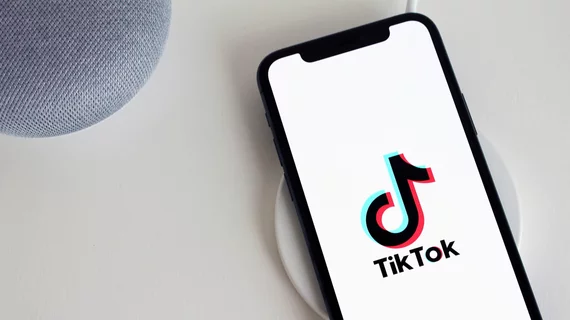Despite its reputation as a frivolous video app for self-styled dancers, TikTok deserves consideration as a means of educating medical students as well as the general public on all things radiology.
It can also serve as a fitting arena for countering radiology-related misinformation.
These are the conclusions of Johns Hopkins researchers who began actively using TikTok in late 2021 and have since drawn close to 250 followers and well more than 600 video likes.
Over a recent 60-day period, their content also attracted more than 8,200 video views, 80 profile views, 57 likes, four comments and five shares.
Research associate Lilly Kauffman, science writer Edmund Weisberg and radiologist Elliot Fishman, MD, recount their experiences in a study published June 11 in Current Problems in Diagnostic Radiology [1].
The team mostly uploaded videos previously created for various non-TikTok purposes. These have included interactive quizzes, clinical cases and amusing yet edifying footage of a sea turtle getting imaged, the authors report.
Radiology Education via TikTok: Available, Albeit Not (Yet) Ample
Kauffman and colleagues also spent time on the social media platform examining its utility from a user’s perspective. Here they found the hashtag #radiology closing in on 400 million views as of April.
Viewing the first 100 of these as guided by TikTok’s “suggested for you” algorithm, they found about half the videos, 46 in number, dealt with life in a radiology department. Examples included observations from patients and insights about working as a radiology technologist.
Most of the rest amounted to a mixed bag of iffy topics and abject tomfoolery:
- One video maker joked about quitting radiology to become a stripper.
- 24 videos shared radiology-related jokes.
- Seven videos showed radiology equipment, “mainly how MRI scanners interact with metal.”
- One zoomed in on a scanner covered in blood, “though the source of the blood is unclear.”
- Three videos addressed sexual desire at work, “including one video about sexual desire for a patient.”
- Seven were posted by radiology professionals but had little or nothing to do with radiology.
The remaining 13 videos included tips and education in radiology and medicine. However, two of those videos contained profanity and three were not in English.
“So, of 100 popular videos, only eight were professional English-language videos,” the authors point out.
Radiology education, they add, “is available on TikTok, but it is not prominent.”
Medical Misinformation Mostly Goes Unmonitored
Kauffman and co-authors further found misinformation proliferating unchecked on TikTok—both in their experience and in prior research.
They cite a 2021 survey of prostate cancer videos on TikTok whose authors reported uncovering “significant misinformation” in around half the videos. Earlier this year, a similar survey of genitourinary cancer content on TikTok found a misinformation rate of 36%.
“Less than 1% of videos removed are due to ‘integrity and authenticity,’ and we are skeptical about TikTok’s ability to identify and erase misinformation in a timely fashion,” as deleted videos “account for only 1% of TikTok's video content,” Kauffman and colleagues comment.
Other key citations include a 2021 analysis by radiology researchers at New York University. In that study, Lovett et al. found 300 posts when they searched for “radiology.” Most of these, 81%, were shared by radiology workers other than radiologists.
However, Lovett and team found the radiologists’ posts drew significantly more views (median 3,643) than those from their nonphysician colleagues (1,282). What’s more, a strong majority of the rads’ posts, 65%, covered clinical interests and stayed on point with medical imaging cases.
From this, the authors of the present study note, Lovett and co-authors concluded that TikTok does indeed present an educational opportunity for radiologists.
Verdict: TikTok Is OK for Radiology Education—‘As Long As It’s Used With Caution’
Kauffman and co-authors warn radiology-focused users of social media to “tread carefully when using the TikTok app for radiology education.” The app is more casual than a typical professional setting, to be sure, but any given radiology department, practice or parent organization is likely to maintain binding guidance and rules around social media.
At the same time, disseminating educationally worthwhile videos on TikTok has considerable potential to do more good than harm, they suggest, adding that more than 12% of the world’s population—including vast swaths of Gen Z—use the app at least once a month.
“Educators can reach a substantial audience, especially [students] in the earliest stages of their medical education,” Kauffman et al. write. “They can also instruct the general public, particularly on topics surrounding radiation exposure and symptoms of illness.”
More:
In this era of social media, TikTok should not be summarily dismissed as a dancing app. Though it is currently not the most suitable app for medical professionals, TikTok warrants consideration for use in radiology education as long as it is used with caution.”
More Coverage of Social Media Use in Radiology:
Reddit presents ‘high-yield’ opportunity for radiologists to engage with peers and patients
Radiology can serve as a ‘force’ to steer conversation on world’s fastest growing social media app
Social media engagement, attendance drop when radiology conferences go virtual
Radiologists in Ukraine helping the war effort as Russia continues to attack
Lung Association’s ‘Turquoise Takeover’ spotlights screening
Reference:
- Lilly Kauffman, Edmund Weisberg and Elliot Fishman: “TikTok for Radiology Education: Is Now the Right Time?” Current Problems in Diagnostic Radiology, June 11, 2022. DOI: https://doi.org/10.1067/j.cpradiol.2022.06.001

